San Andreas strawberry variety
Not so long ago, an American variety of neutral daylight hours (remontant) Albion literally turned the attitude towards strawberries as a seasonal berry and the ways of growing it. And now, after some time, when all the shortcomings of the "American" were clarified, gardeners and farmers were looking forward to the appearance of a new neutral, so to speak, "improved" Albion. And finally, he entered our market. But whether it has become a really worthy replacement and a promising choice for growing in Russia - this will be discussed below.

History of creation
The neutral daylight variety San Andreas was bred in 2001 by breeders Douglas W. Shaw and Kirk D. Larson. The Albion variety and the Cal 97.86-1 number selection were crossed. The resulting plants were numbered Cal 1.139-2 and planted at the University of California Wolfskill Experimental Orchard near Winters. In the same place, in 2002, the first harvest was obtained, then asexual reproduction was carried out using the rosettes formed on the whiskers, which are given by strawberries. After selection and testing, the "novelty" was assigned the number CN223, and later, when the direct sales of seedlings began, it was given the name San Andreas. This is the name of a settlement and a reservoir lake in California, as well as a 1300 km long transform fault between the Pacific and North American plates, passing along the coast through the state of California. In 2005, the cultivar was tested at the Watsonville Strawberry Research Facility, the South Coast Research and Extension Center. After the scientists were convinced that the varietal traits were fixed and preserved during subsequent reproductions, the registration procedure began and the tests of strawberries in various parameters continued. And in 2008, the first patent was obtained, valid until 2028. San Andreas is officially owned by the University of California, USA.
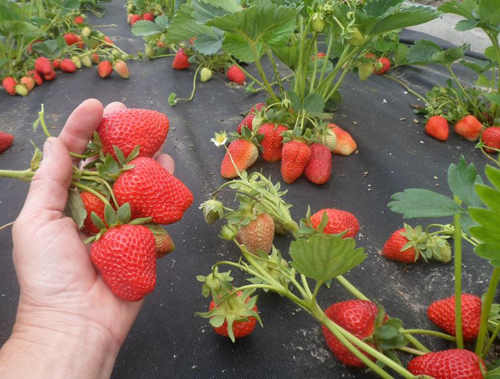
Description
The plant is vigorous, but the average height is 25 cm and the width is 32 cm, the bush is medium-leafy, relatively compact. The leaves themselves are large, moderately pubescent, toothed, deep green, darker at the beginning of the season than in subsequent months. The peduncles of the variety are powerful, the flowers on them are large, located above the leaves. The flower stalks hold the berry when it is not yet ripe, and then sink under their weight. Although, in principle, we have not yet met large-fruited strawberries, in which flower stalks can hold ripe fruits. This can only be found on small-fruited strawberries and earthworms. The San Andreas whiskers produce an average amount, but they are powerful, the rosettes on them are large and, when rooting, quickly develop into a full-fledged plant. A small number of whiskers facilitates care and reduces labor costs, but if the goal is to multiply the plantation, then you need to cut the peduncles, pluck the flower itself and apply fertilizers with a high nitrogen content.
The berries are tasty, sweet, with a strawberry aroma, similar in tasting characteristics to Albion, but without the "apple" crunch, the flesh is not so oaky, more juicy, the skin is strong and elastic. According to the author of the article, San Andreas loses slightly to the taste of the parent, he is more saturated, so to speak, "rich".
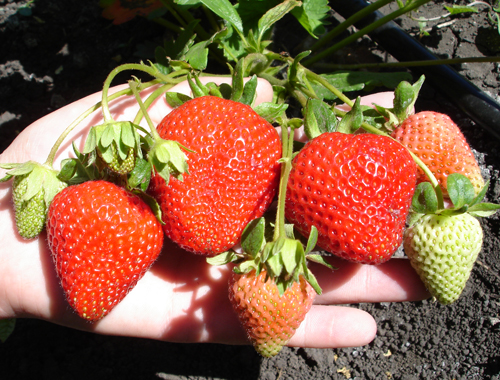
Strawberry fruits are really beautiful, rich bright red, sometimes closer to red-orange, lighter than Albion, with a glossy shine. They are large and very large, with an average weight of 25-30 grams, but you can often find specimens weighing 50-60 grams, especially in the first early spring harvests and autumn from the second half of September, when the heat has already subsided. The berries are uniform, aligned, symmetrical, elongated-conical, with a more rounded nose than that of the “parent”. When fruiting, San Andreas produces a very high percentage of first-class berries (90%).
Moreover, the shape and quality of the berry is preserved throughout the strawberry harvesting season, there is a high percentage of one-dimensional fruits (60-80%). Their average length is 5.8 cm, width is 4.4 cm, the ratio of length to width is 1.3. The hollow part inside the fruit is practically absent, the pulp is orange-pink. The seeds are medium-sized, located on the surface of the fruit or are slightly depressed into it. The color of the achenes is from yellow to dark red.
The taste and sweetness of the fruit remains at the proper level throughout the season, even in an unripe, semi-green berry (especially for late autumn harvests). Also, in rainy weather and light frosts, strawberries remain firm and retain their high tasting characteristics. Moderate acidity and a good percentage of sugar in the fruit contribute to excellent taste. The Brix value (Brix - mass fraction of sugar) ranges from 7 to 10 according to the results of studies carried out at various temperatures, starting from + 20 °.
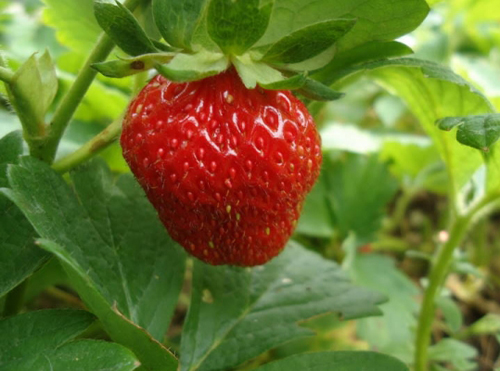
Transportability and keeping quality of fruits is at a high level, even without refrigeration. According to these indicators, San Andreas is similar to his parent, Albion. The variety is excellent for both the fresh market and for processing, freezing, used in cooking. And of course, it is an excellent way to grow both in summer cottages and in fields on an industrial scale.
Let's talk about interesting facts about yield. In 2005-2007, the South Coast Research Center in Watsonville conducted comparative studies of San Andreas and three other varieties. The strawberry seedlings were provided by a California commercial nursery. They were planted in the ground on October 15-16, but the harvest began in early April and lasted until October 8 of the following year. The planting pattern is two-line, the total number of plants in an area of one hectare (one acre) was 17,300 pieces.
Harvest Appearance Mass Hardness
Name (gram / bush) (5 is the best) (1 berry, gram) pulp
Aromas 3108 3.1 27.0 9.6
Diamond 2653 3.5 31.2 11.0
Albion 2461 3.9 30.5 11.1
San Andreas 3293 4.4 31.6 11.5
Our hero shows good results in the second year, compared to Albion, it is much more resistant to diseases and pests, in particular to ticks. Its root system is better developed, and therefore, it tolerates interruptions in watering (drought) more calmly, and the likelihood of complete freezing of strawberries during a harsh winter decreases. And also, the better the root system is developed, the more it provides nutrition to the plant itself, which affects the timing of the onset of fruiting, the quality and quantity of berries.
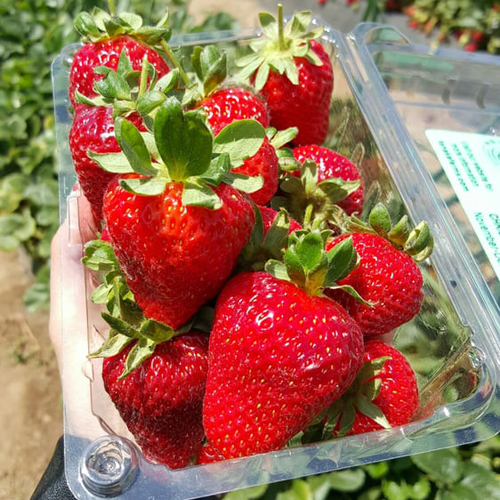
San Andreas is similar to other neutral varieties in that it will flower regardless of the length of the day, given the appropriate temperature and horticultural conditions. Bushes constantly form full-fledged strong peduncles, of which there can be more than 10 pieces at once.
Our hero is well suited for growing outdoors, as well as under cover. It is considered one of the best in its class for cultivation in a controlled environment (greenhouse). Strawberries adapt very well to different growing conditions in different countries with different climatic conditions. It bears fruit successfully in low light conditions, suitable for growing in autumn-winter circulation in protected ground - greenhouses with heating and lighting.
The bushes of San Andreas themselves are relatively compact, which makes it possible to plant more plants in the required area without harming them. This plays an important role in the continued success of your plantation. After all, different varieties have different growth rates and the size of the vegetative mass, this must be taken into account when planning future plantings. Because when the plants are thickened, there is a high probability of severe disease damage, and the size of the berries becomes smaller. The optimal distance between strawberry bushes is 30-35 cm, and 50-100 cm between rows. A two-line planting scheme is widespread and effective - the distance between the plants in the tape is from 30 cm, between the tapes - from 30 cm.On an industrial scale, the width between the rows is, of course, greater, this is done for ease of maintenance and mechanized processing with the help of technology. Basically, the row spacing is from 1 meter.
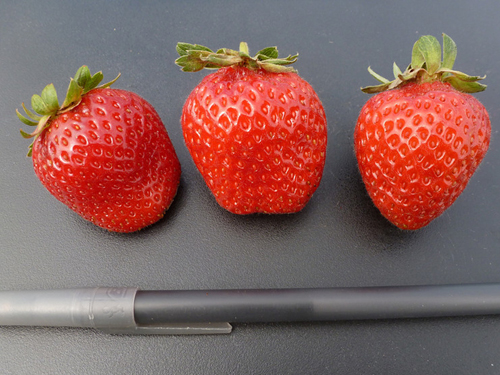
Now let's try to outline all the pros and cons of the American variety.
Patent yields, according to research by Watsonville, reached a record 3.3 kg per plant per season. These are really excellent indicators and reveal the entire commercial potential of the variety. Plus, the good news is that for this analysis of the productivity and quality of berries, strawberries were grown in the open field, in a field of one hectare. But, unfortunately, it is possible to achieve such results, but in our conditions, especially in the open field, it is problematic. We do not have California, where San Andreas was tested, with its absence of winter in our understanding. Also, feeding and processing were carried out on a weekly basis for proper nutrition and plant development. Most likely, few people in our country will agree to use fertilizers every week, and then eat berries. But to achieve in our country 1 kg of berries from a bush or more is already real.
Thanks to the dense pulp, the berries can withstand small frosts, and the frost resistance of the plants itself is at the proper level. Up to -20 ° С it is possible, but it is undesirable to grow without shelter with agrofibre (lutrasil) for the winter.
According to patent data, San Andreas is moderately resistant to powdery mildew, anthracnose, verticillium wilt, late blight and leaf blight. With proper farming practices, strawberries are tolerant to spider mites. The cultivar is also tolerant to the strawberry viruses found in California.
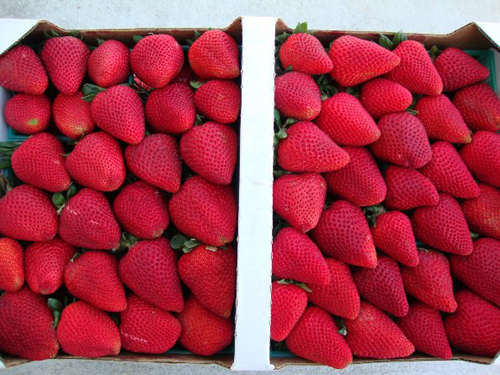
Our hero is actually resistant to many diseases and, in particular, to the "scourge" of Albion - spots, even without fungicide treatments. Occasionally, spots can appear especially on the lower and old leaves, therefore, to maintain the health of the whole plant, it is very desirable to carry out sanitary cleaning (remove diseased and dried leaves, as well as overripe or dried berries). Another variety is quite resistant to the tick. When growing San Andreas, you can do without chemicals at all, but a couple of treatments per season with fungicides and insecto-acaricides will never be superfluous, they will only add strength to the strawberries and have a positive effect on subsequent fruiting. Moreover, subject to the consumption rates of drugs during processing recommended by the manufacturer and indicated on the packaging, processing will not cause practically any harm to human health, which has been verified by numerous studies. But often farmers, and besides, farmers, ordinary summer residents literally poison plants (and then people who consume the fruits of these plants) with a huge number of fertilizers and chemical remedies, cynically exceeding the necessary and recommended rates and frequency of treatments. By the way, ardent opponents of chemistry should not despair either - now the market offers the widest range of effective biological products, for example, the well-known and really well-working insecto-acaricide Aktofit. But it is very important to buy drugs from trusted sellers and monitor the expiration dates (this is especially important for biological products), as well as the air temperature when processing the culture. Efficiency directly depends on this, because at different temperatures, plant protection products work differently.
San Andreas needs regular and balanced nutrition in the form of a cocktail of mineral fertilizers and stimulants. Like all varieties of neutral daylight hours, strawberries spend a significant amount of energy on frequent fruiting and take out a lot of trace elements from the soil, therefore, additional feeding is necessary to achieve good results.The alternation of the use of fertilizers both under the root (watering) and on the leaf (spraying) is especially good. The introduction of rotted manure into the soil before planting has a very positive effect.
The indisputable advantages of San Andreas are a beautiful shiny berry, homogeneous, tasty, aromatic, with excellent market indicators, great potential in yield, regular fruiting.
Of the nuances, it should be noted the need for annual planting updates. Varieties of neutral daylight hours, subject to a full season, quickly develop their resource. And in the second year, the yield and size of berries decrease, the likelihood of being affected by diseases becomes more likely, and strawberries practically cease to give a mustache for reproduction. Therefore, if possible, it is better to update the landing more often. But such varieties as San Andreas, some leave for the second year, provided good "nutrition". You obviously will not be left without berries, but the plant, of course, will not show such results as in the first year of fruiting.
There is a high probability of falsification of seedlings by dishonest sellers, of which, unfortunately, there are plenty. And there are enough of those who grow another variety, thinking that this is San Andreas, and, accordingly, sell seedlings obtained from these plants. Therefore, do not take strawberry seedlings from just anyone, in the markets
At the end of the article, you can add the following. This variety is really capable of delighting you with excellent berries throughout the season, so love it, take care of it, and it will reward you for all your efforts!
Author: Maxim Zarechny.




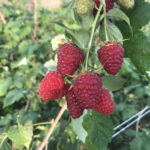
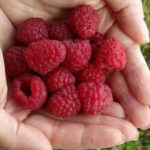



San Andreas has been growing in my garden for the third year in a row. Planting was carried out by seedlings, and in the first year we tried the first small harvest. In subsequent years, the strawberries grew well and produced many berries until late autumn. At the end of October, we do the last cleaning, after which we sprinkle the bushes with spruce needles for the winter. The berries of this variety are large and tasty, excellent both fresh and preserved.
Great article! thank